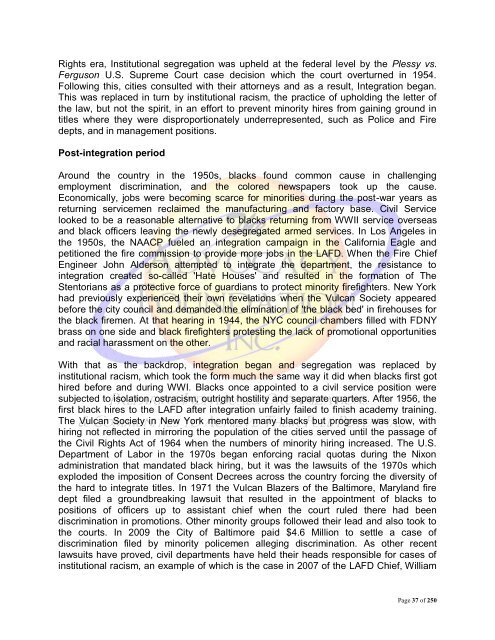Institutional Racism
Institutional Racism
Institutional Racism
You also want an ePaper? Increase the reach of your titles
YUMPU automatically turns print PDFs into web optimized ePapers that Google loves.
Rights era, <strong>Institutional</strong> segregation was upheld at the federal level by the Plessy vs.<br />
Ferguson U.S. Supreme Court case decision which the court overturned in 1954.<br />
Following this, cities consulted with their attorneys and as a result, Integration began.<br />
This was replaced in turn by institutional racism, the practice of upholding the letter of<br />
the law, but not the spirit, in an effort to prevent minority hires from gaining ground in<br />
titles where they were disproportionately underrepresented, such as Police and Fire<br />
depts, and in management positions.<br />
Post-integration period<br />
Around the country in the 1950s, blacks found common cause in challenging<br />
employment discrimination, and the colored newspapers took up the cause.<br />
Economically, jobs were becoming scarce for minorities during the post-war years as<br />
returning servicemen reclaimed the manufacturing and factory base. Civil Service<br />
looked to be a reasonable alternative to blacks returning from WWII service overseas<br />
and black officers leaving the newly desegregated armed services. In Los Angeles in<br />
the 1950s, the NAACP fueled an integration campaign in the California Eagle and<br />
petitioned the fire commission to provide more jobs in the LAFD. When the Fire Chief<br />
Engineer John Alderson attempted to integrate the department, the resistance to<br />
integration created so-called 'Hate Houses' and resulted in the formation of The<br />
Stentorians as a protective force of guardians to protect minority firefighters. New York<br />
had previously experienced their own revelations when the Vulcan Society appeared<br />
before the city council and demanded the elimination of 'the black bed' in firehouses for<br />
the black firemen. At that hearing in 1944, the NYC council chambers filled with FDNY<br />
brass on one side and black firefighters protesting the lack of promotional opportunities<br />
and racial harassment on the other.<br />
With that as the backdrop, integration began and segregation was replaced by<br />
institutional racism, which took the form much the same way it did when blacks first got<br />
hired before and during WWI. Blacks once appointed to a civil service position were<br />
subjected to isolation, ostracism, outright hostility and separate quarters. After 1956, the<br />
first black hires to the LAFD after integration unfairly failed to finish academy training.<br />
The Vulcan Society in New York mentored many blacks but progress was slow, with<br />
hiring not reflected in mirroring the population of the cities served until the passage of<br />
the Civil Rights Act of 1964 when the numbers of minority hiring increased. The U.S.<br />
Department of Labor in the 1970s began enforcing racial quotas during the Nixon<br />
administration that mandated black hiring, but it was the lawsuits of the 1970s which<br />
exploded the imposition of Consent Decrees across the country forcing the diversity of<br />
the hard to integrate titles. In 1971 the Vulcan Blazers of the Baltimore, Maryland fire<br />
dept filed a groundbreaking lawsuit that resulted in the appointment of blacks to<br />
positions of officers up to assistant chief when the court ruled there had been<br />
discrimination in promotions. Other minority groups followed their lead and also took to<br />
the courts. In 2009 the City of Baltimore paid $4.6 Million to settle a case of<br />
discrimination filed by minority policemen alleging discrimination. As other recent<br />
lawsuits have proved, civil departments have held their heads responsible for cases of<br />
institutional racism, an example of which is the case in 2007 of the LAFD Chief, William<br />
Page 37 of 250

















